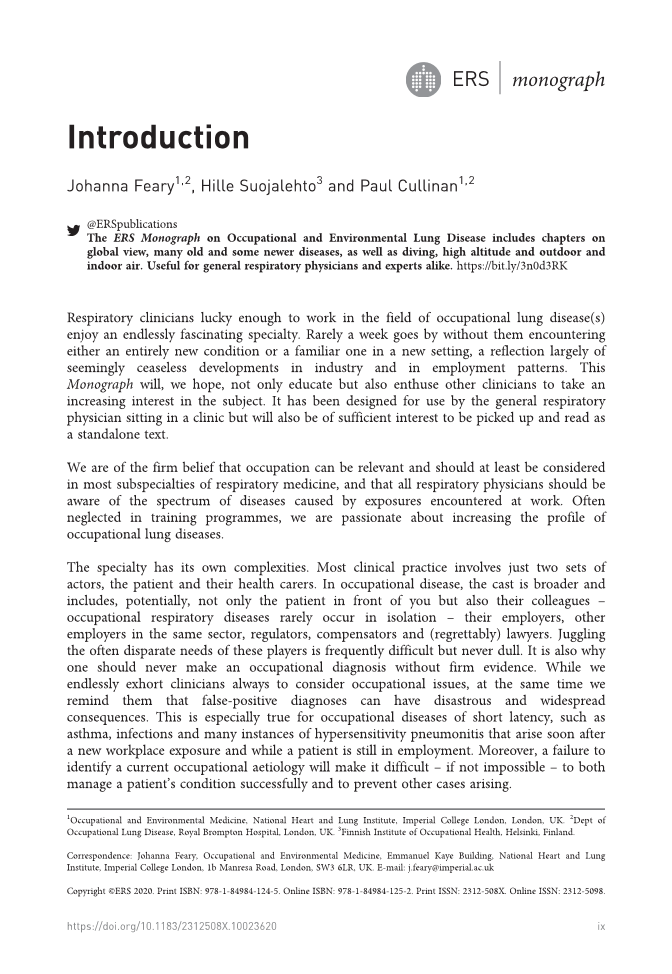ERS | monograph Introduction Johanna Feary1,2, Hille Suojalehto3 and Paul Cullinan1,2 @ERSpublications The ERS Monograph on Occupational and Environmental Lung Disease includes chapters on global view, many old and some newer diseases, as well as diving, high altitude and outdoor and indoor air. Useful for general respiratory physicians and experts alike. https://bit.ly/3n0d3RK Respiratory clinicians lucky enough to work in the field of occupational lung disease(s) enjoy an endlessly fascinating specialty. Rarely a week goes by without them encountering either an entirely new condition or a familiar one in a new setting, a reflection largely of seemingly ceaseless developments in industry and in employment patterns. This Monograph will, we hope, not only educate but also enthuse other clinicians to take an increasing interest in the subject. It has been designed for use by the general respiratory physician sitting in a clinic but will also be of sufficient interest to be picked up and read as a standalone text. We are of the firm belief that occupation can be relevant and should at least be considered in most subspecialties of respiratory medicine, and that all respiratory physicians should be aware of the spectrum of diseases caused by exposures encountered at work. Often neglected in training programmes, we are passionate about increasing the profile of occupational lung diseases. The specialty has its own complexities. Most clinical practice involves just two sets of actors, the patient and their health carers. In occupational disease, the cast is broader and includes, potentially, not only the patient in front of you but also their colleagues – occupational respiratory diseases rarely occur in isolation – their employers, other employers in the same sector, regulators, compensators and (regrettably) lawyers. Juggling the often disparate needs of these players is frequently difficult but never dull. It is also why one should never make an occupational diagnosis without firm evidence. While we endlessly exhort clinicians always to consider occupational issues, at the same time we remind them that false-positive diagnoses can have disastrous and widespread consequences. This is especially true for occupational diseases of short latency, such as asthma, infections and many instances of hypersensitivity pneumonitis that arise soon after a new workplace exposure and while a patient is still in employment. Moreover, a failure to identify a current occupational aetiology will make it difficult – if not impossible – to both manage a patient’s condition successfully and to prevent other cases arising. Copyright ©ERS 2020. Print ISBN: 978-1-84984-124-5. Online ISBN: 978-1-84984-125-2. Print ISSN: 2312-508X. Online ISSN: 2312-5098. Correspondence: Johanna Feary, Occupational and Environmental Medicine, Emmanuel Kaye Building, National Heart and Lung Institute, Imperial College London, 1b Manresa Road, London, SW3 6LR, UK. E-mail: j.feary@imperial.ac.uk 1 Occupational and Environmental Medicine, National Heart and Lung Institute, Imperial College London, London, UK. 2 Dept of Occupational Lung Disease, Royal Brompton Hospital, London, UK. 3 Finnish Institute of Occupational Health, Helsinki, Finland. https://doi.org/10.1183/2312508X.10023620 ix
